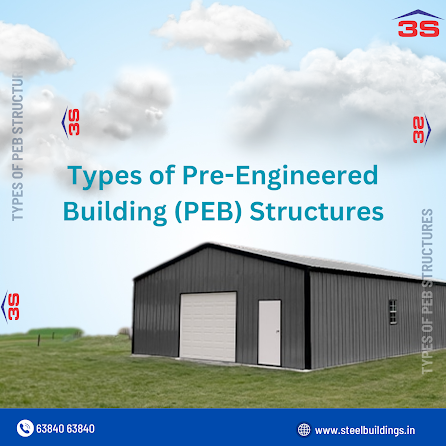Pre-Engineered
Buildings (PEB) have become a popular choice in modern construction due to
their versatility, cost-effectiveness, and rapid assembly. They are designed to
be manufactured off-site and assembled on-site, offering a range of structural
configurations to suit various applications. Here, we explore the different types of PEB structures,
highlighting their features, advantages, and typical uses.
1. Industrial Buildings
Characteristics:
Industrial
PEBs are designed to accommodate manufacturing, warehousing, and other
industrial processes. They typically feature large open spaces, high ceilings,
and robust structural systems to support heavy machinery and storage needs.
Advantages:
Large Span Structures: These buildings often employ wide-span frames, reducing the
need for interior columns and providing unobstructed floor space.
Cost Efficiency: Prefabricated components help in reducing construction time
and labor costs.
Flexibility: Industrial PEB Structure can be easily expanded or modified
based on changing business needs.
Applications:
·
Manufacturing plants
·
Warehouses
·
Distribution centers
·
Assembly facilities
2.
Commercial Buildings
Characteristics:
Commercial
PEBs cater to various business needs, including retail spaces, office
buildings, and service centers. They often feature attractive facades and
design elements to appeal to customers and clients.
Advantages:
Aesthetic Appeal: PEB
Structure can be customized with different finishes and materials,
allowing for eye-catching designs.
Sustainability: Many commercial PEBs incorporate energy-efficient systems
and sustainable materials.
Speed of Construction: Quick assembly helps businesses start operations sooner,
benefiting from reduced downtime.
Applications:
·
Retail outlets
·
Office complexes
·
Showrooms
·
Service stations
3.
Agricultural Buildings
Characteristics:
Agricultural
PEBs are designed for farming operations and livestock housing. These
structures need to accommodate specific requirements such as ventilation,
accessibility, and climate control.
Advantages:
Durability: Built to withstand harsh weather conditions, agricultural
PEBs are often more resilient than traditional structures.
Customizability: They can be designed for various agricultural uses,
including barns, silos, and storage facilities.
Cost-Effective: Reduced labor and material costs make PEBs an economical
choice for farmers.
Applications:
·
Livestock barns
·
Grain storage facilities
·
Poultry houses
·
Equipment storage sheds
4.
Institutional Buildings
Characteristics:
Institutional
PEBs include schools, hospitals, and community centers. These buildings
prioritize safety, functionality, and accessibility for diverse populations.
Advantages:
Quick
Turnaround: The speed of construction allows institutions to respond to growing
community needs swiftly.
Compliance: PEBs can be designed to meet specific building codes and
safety regulations.
Energy Efficiency: Many institutional buildings incorporate green technologies
and energy-saving systems.
Applications:
·
Schools and colleges
·
Hospitals and clinics
·
Community centers
·
Libraries
5.
Recreational Buildings
Characteristics:
Recreational PEBs are designed for sports, fitness, and leisure activities. They often include large open spaces, high ceilings, and amenities tailored for public use.
Advantages:
Versatility: These structures can accommodate various activities, from
sports to community events.
Cost-Effective: Prefabrication reduces costs and allows for customizable
designs based on specific recreational needs.
Quick Assembly: Rapid construction means facilities can open sooner for
community use.
Applications:
·
Gyms and fitness centers
·
Sports arenas
·
Community recreational facilities
·
Indoor swimming pools
6.
Residential Buildings
Characteristics:
While
less common, PEBs can also be used for residential purposes, providing
innovative housing solutions. These structures can range from single-family
homes to multi-unit complexes.
Advantages:
Affordable Housing: PEBs offer a cost-effective alternative to traditional
construction, helping to address housing shortages.
Speed of Construction: Rapid assembly can reduce the time from design to
occupancy.
Customization: Homeowners can customize layouts and finishes to meet
personal preferences.
Applications:
·
Single-family homes
·
Townhouses
·
Apartment complexes
·
Modular housing units
7.
Specialty Structures
Characteristics:
Specialty
PEBs are tailored for unique purposes, such as aircraft hangars, military
facilities, or research laboratories. These buildings often incorporate
specialized features to meet specific operational requirements.
Advantages:
Tailored Solutions: Designed to meet specific needs, these structures can
incorporate advanced technology and safety features.
Durability and Strength: Specialty PEBs are often built to withstand extreme
conditions or heavy usage.
Efficient Use of Space: Custom designs maximize functionality while maintaining
structural integrity.
Applications:
·
Aircraft hangars
·
Military facilities
·
Research and development labs
·
Data centers
Conclusion
Pre-Engineered
Buildings offer a range of options for various applications, making them a
versatile choice for builders and developers. From industrial and commercial
structures to agricultural and recreational facilities, PEBs are designed to
meet specific needs while providing significant cost and time savings. As the
demand for efficient and sustainable building solutions continues to grow, the
popularity of PEBs is likely to increase, paving the way for innovative designs
and applications in the construction industry.

Comments
Post a Comment